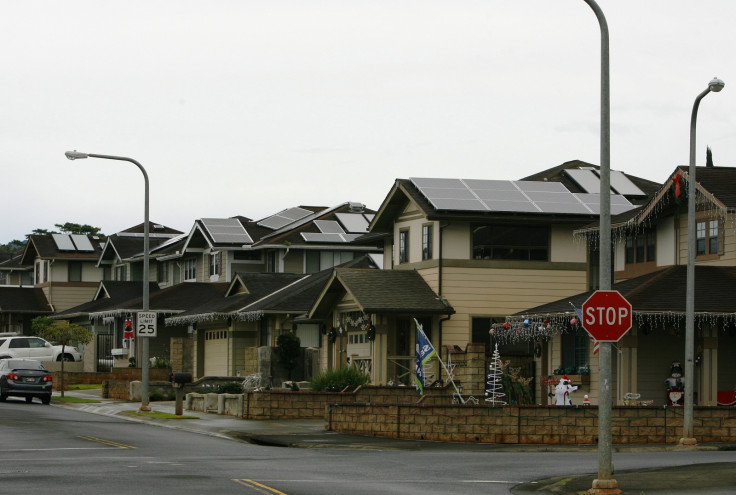Earth Day 2015: Dazzling solar power singes fossil fuel industry

Solar energy is good for the planet, but not for the fossil fuel industry.
Lengthy backlogs of solar rooftop applications for homes in Hawaii come as the latest evidence of disincentives for the growing solar market worldwide.
Mirroring the popularity of rooftops in the US, almost 12% of Hawaii's homes boast a rooftop system.
The state utility Hawaiian Electric Company says the growing solar home power connected to the grid is causing unanticipated voltage fluctuations that can overload circuits, burn lines and lead to brownouts or blackouts.
When the amount of excess power fed into the grid exceeds what is used, the grid can become unstable. As more homes opt for grid connected solar power, it places pressures on old infrastructure like circuits and power lines, besides cutting into the utility's revenue.
With a new rooftop solar system installed every three minutes in the US, home solar is rapidly spreading across the US too, causing utilities to reduce incentives, increase monthly surcharge and push solar companies out of the market.
Attempts to smother
There are now about 600,000 installed systems, and the number is expected to reach 3.3 million by 2020, according to the Solar Energy Industries Association.
In many states, homes are being charged $3000 (£2016) for "interconnection studies" to control the rush for home-based power.
In Arizona with more than 127,000 homes having rooftop arrays, the utilities initially asked for a $100-a-month surcharge, which was later reduced to about $5 a month. In Wisconsin, where rooftop solar is still relatively rare, regulators approved an annual fee of $182 a year.
Net metering that allows consumers (turned producers) to sell excess power, often at lower rates than the utilities, is posing a threat to the survival of utilities.
The utilities claim that homes are getting a free ride on the grid without paying up for construction and maintenance costs which have to be recovered. Solar advocates point that utilities are ignoring the load-reducing benefits of distributed energy in their planning.
Battery storage technology or micro turbines could soon allow customers to be electric grid independent, say experts.
Global scene
In the developing world too, solar power is catching up fast.
In India, several states have exempted solar projects from "wheeling" charges allowing solar developers to send power over the grid to commercial and industrial buyers for almost no charge.
This is expected to prompt a backlash by utilities who lose out on their highest-paying clients.
Between 2012 and 2014, solar capacity increased from 461 megawatts to over three gigawatts with another two gigawatts to be added this year. The price of solar power has fast fallen by a third in three years.
Prime Minister Narendra Modi has set an ambitious goal to install 100 gigawatts of solar power capacity — over 30 times more than India has now — by 2022.
Meanwhile, China connected 5.04 gigawatts of solar capacity to its grids in the three months ended 31 March, notching a total 33 gigawatts of solar-power supply.
The global installed capacity of solar electricity has increased by six times to 135GW in 2013 from 23GW in 2010.
Falling prices
Solar power is fast approaching grid parity with fossil fuel power, and in some cases falling even lower as wafers go thinner and more effective in sunlight conversion. Solar photovoltaic prices have fallen by 80% since 2008.
A report released late last year by German think tank Agora Energiewende, predicted solar energy would become the cheapest source of electricity in many parts of the world within the next 10 years.
In such a scenario, a repeat of what is being seen in the US and Hawaii can be expected across the globe as the fossil fuel industry and utilities scramble to tackle the solar home insurgency threat.
Hopefully, the efforts to clean energy will not be derailed. The warming world cannot afford that.
World electricity generation is forecast to grow by 67% from 22,126 terawatt-hour in 2011 to 37,000 in 2030. A major part of this additional capacity will be met by fossil fuels.
Electricity production from fossil fuels accounts for more than 40% of man-made CO2 emissions.
These emissions need to drop fast and for that the world has to be weaned away from fossil fuels by the end of the century to avoid irreversible climate change.
As the world celebrates another Earth Day on 22 April, it is time to shed old habits and adopt new and clean ways.
There is enough and more of solar energy to cater to the world's needs. Sunlight that falls on the earth's surface in 40 minutes equals the total annual energy consumption of the planet's humans. Just 1% of that is currently used to generate power.
It is time to exploit that abundance, not sabotage.
© Copyright IBTimes 2025. All rights reserved.





















